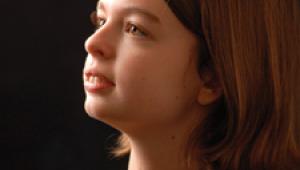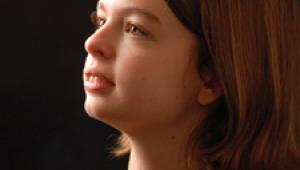Portraiture
Getting Under The Skin
Photos © 2004, Steve Anchell, All Rights Reserved
Well, I don't know if I should really call this a self-assignment, as
it came my way when I was called upon to supply a chapter for a book. The only
problem with the assignment was that I only had 30 days to complete it, including
illustrations. Even though I have done just about everything in photography
from Hollywood glamour to hanging out of a Piper Cub for aerial photography,
I have always considered myself a portrait photographer, first and foremost.
With 30 days to complete the assignment I wrote the chapter in three days. The
rough draft referenced over 20 unique images, all except three which I needed
to make (two were to be submitted by photographer Judy Gelles, though she didn't
know it yet, and one was from my archives). Twenty portraits in 27 days may
seem like a piece of cake to some. If you think about it, it's less than
3/4 of a portrait a day.
For me, portraiture is about knowing your subject well enough that you are able
to capture the space between who they are and who they think they are. Even
if you have just met the person for the first time, a good portrait gets below
the skin to capture the essence of the person. When your subject is able to
recognize themselves, beyond mere appearance, you have succeeded. Anything else
is just a likeness.
Enhance Your Images With Photoshop
Capture is only the beginning with digital. Almost any image can be enhanced
or improved by retouching in a program such as Adobe Photoshop. By listening
to the professional and enlisting the aid of some of the best programmers available,
Photoshop has become the de facto program for professional photographers to
use. While Photoshop may seem to be daunting at first, after you have worked
with the program for a while you will find the possibilities for improving your
work and expanding your imagination are limitless.
Here's a portrait of Al and BG Purvis. I entered their home for the first
time. What they expected was that I would walk in, take the photo and leave.
Instead, I set down my tripod and camera bag and engaged them both in conversation.
Before long I found out that Al had been a musician in the US Army during World
War II and later played horn in a Big Band. I found out from BG that she had
always been a "party gal" and loved the wild life she and Al had
shared. While we chatted I casually looked around the room and found what I
felt was the best background and location. After 30 minutes or more I asked
Al to get his horn and for the two of them to move to the chair, which I pulled
into place from across the room. I allowed them to pose themselves.
This is how you get under the skin, how you find the space between. You take
the time to get to know your subject. If you don't have time or interest
in doing this, then portraiture is not your bag.
 |
For the book my first subject was artist Deborah Easley. For this portrait
I arranged Deborah with her gourds in front of her fireplace. A Profoto Compact
Plus 1200 monolight with a large Photoflex softbox was placed outside the living
room window at camera right. A white card was placed behind Deborah. I used
a Mamiya 645AFD with a Leaf Valeo 6 digital back to capture this image.
I prefer medium format for group portraiture and formal wedding photography.
The 6-megapixel image equates to an 18MB image file, in 16-bit format. The medium
format ensures over 65,000 tone levels in each channel, extremely low noise
levels, and a wide dynamic range. All of this allows me to make an excellent
enlargement of at least 20x24".
 |
However, it is not just enlargement size that matters. Medium format images, from film or digital cameras, capture significantly finer detail and create smoother tonality. If you want to see an immediate improvement in the quality of your images move up in size to medium format. If you are a pro, or thinking of turning pro, and want to provide your clients with the best possible quality, then medium format is definitely the way to go.

















































